
|
About Oriental Rug Construction
Knotted, Tufted and Flat-Woven Rugs; Knot Types and Density
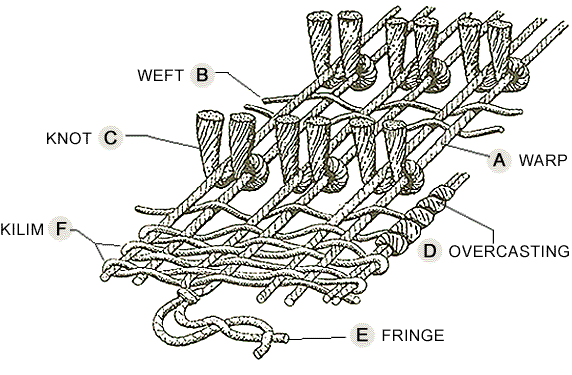
|
Anatomy of A Hand Knotted Rug
- WARP - The parallel threads running through the entire length of the rug
onto which the knots are tied.
- WEFT - The threads running across the width of the rug inserted between all the rows
of knots. These threads pass through alternate warp threads. Their job is to secure the knots in
parallel lines and to strengthen the fabric.
- KNOT - The term used for a strand of wool yarn which is looped around two
adjacent warp threads and then cut to form the pile (surface of carpet).
- OVERCASTING - A simple wrapping of dyed yarn along the entire length of both sides of
a handmade rug.
- FRINGE - The visible continuation of the warp threads at both ends of the carpet.
- KILIM - The pileless web of warp and weft between the rug's pile and the knotted
fringe. This is also the name for a rug without pile.
|
Types of Oriental Rug Construction
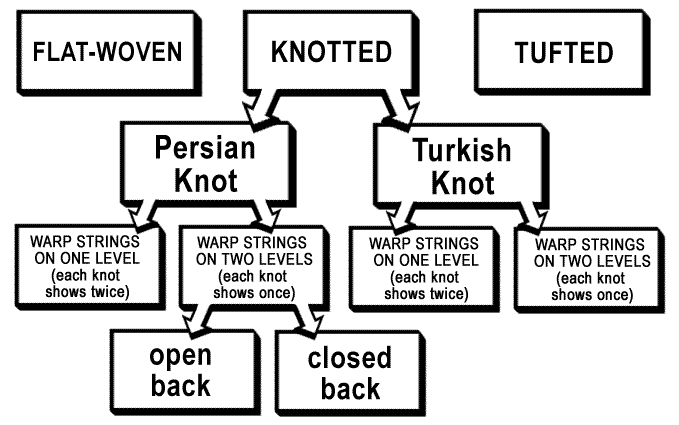
Who Uses Which Knot?
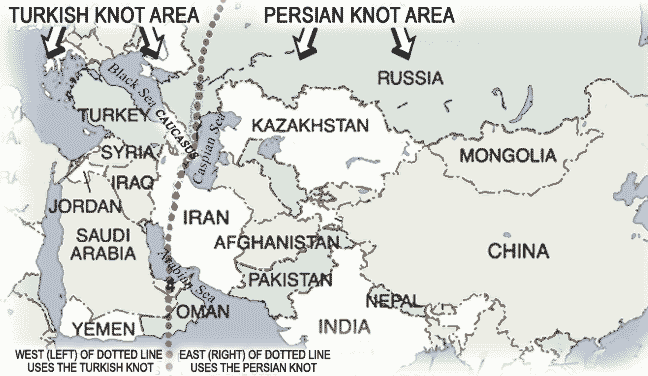
Line of division (dotted line):
distinguishing Turkish Knot (west of line) and Persian Knot areas (east).
|
PERSIAN KNOT
WITH ALL OF THE WARP THREADS ON ONE LEVEL
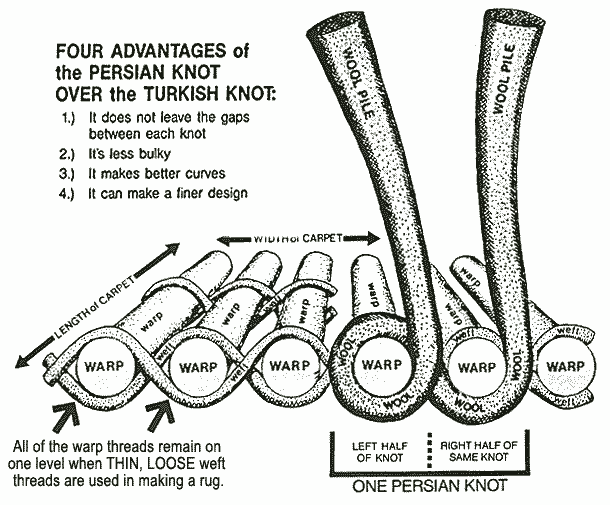
TURKISH KNOT
WITH ALL OF THE WARP THREADS ON ONE LEVEL
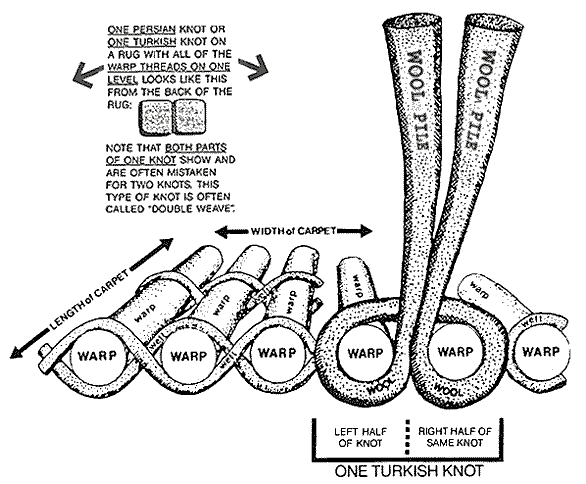
Persian Knot
WITH THE WARP THREADS ON TWO DIFFERENT LEVELS
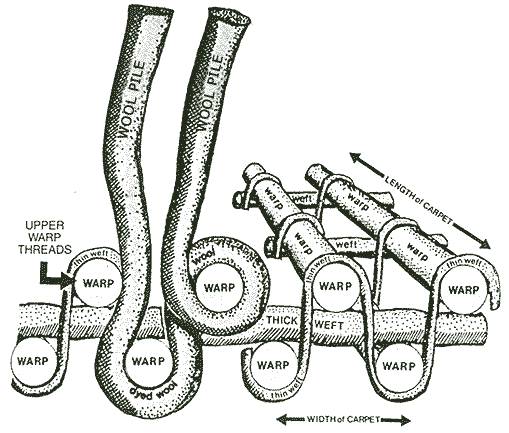
|
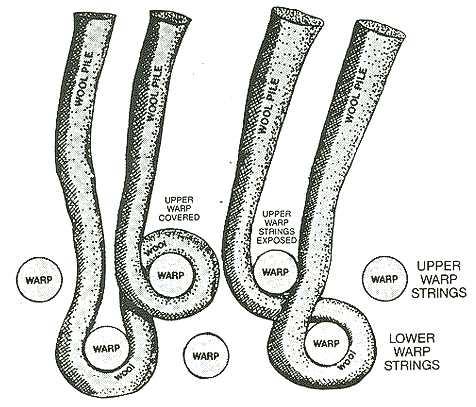 |
OPEN BACK
|
|
CLOSED BACK
|
The FULL LOOP part of the KNOT is on the UPPER warp thread
- TRADITIONAL PERSIAN KNOT USED IN INDIA, PAKISTAN, CHINA,
IRAN (except western part)
- IDEAL FOR 1/4, 3/8, or 1/2 PILE
- MAKES MORE FLEXIBLE RUG
- SPECKS of WEFT SHOW FROM THE BACK OF RUG (normally white)
|
|
In the CLOSED BACK KNOT the FULL LOOP is on the LOWER warp thread
- ONLY USED IN CHINA
- CONCEALS WEFTING (No white specks visible from back of rug)
- IDEAL FOR VERY THICK RUGS
- TAKES A THICKER YARN
|

DIFFERENT METHODS FOR FINISHING THE UNDERSIDE OF A RUG
|
|
Counting Knots Correctly
Counting knots on an oriental rug is easy to learn. Unfortunately most "expert" knot counters
do not realize one knot is often counted as two knots and with the use of unplyed strands
of yarn, one knot has been mistaken for eight knots or more! We must first learn what
one knot looks like from the rug's back.
On the back of a handknotted rug you will see thousands of tiny squarish "bumps" (see below).
We must learn the relationship between these "bumps" and the knots. These squarish "bumps" are the
visible parts of the knots that loop around the warp threads as shown below.
Every Persian and Turkish knot has two loops but only some rugs show both.
Most rugs show only one of the loops. A few rugs show one loop but just part of the other loop.
Before counting knots we must be sure we are counting each knot only once.
RUG KNOTS THAT SHOW TWICE (1 Warp Level)
|
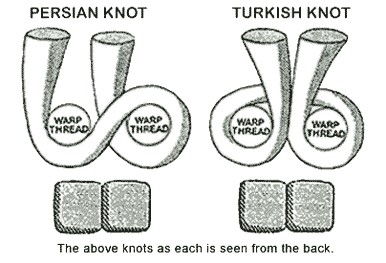
|
WHY TWICE?
When all the warp threads are on the same level, both loops (bumps) show
from the back of the rug as shown here.
WHICH RUGS DO THIS?
All Pakistan Bokharas & tribal rugs from Iran, Turkey, Afghanistan, etc.
HOW TO SPOT
Each "bump" will always have an identical twin "bump next to it.
|
|
RUG KNOTS THAT SHOW ONCE (2 Warp Levels)
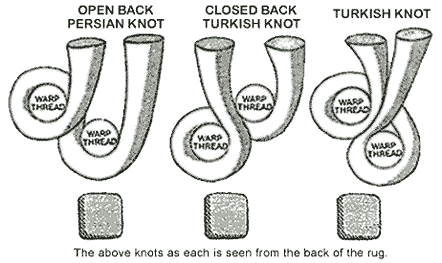
|
WHY ONCE?
When there are two layers of warp threads, one of the two knot loops goes "upstairs"
and out of view as shown here.
WHICH RUGS?
Chinese, Indian and many other rugs do this.
HOW TO SPOT
Look around for single "bumps" that do not have the identical bump next to them.
|
|
Amazing But True!
- Our rugs use the same methods & materials that
have been used for thousands of years.
- The average weaver ties more than 10,000 knots a day ... each one by hand.
- A room size Oriental rug takes many months to make. Some oriental rugs have taken years
to complete.
- One good quality room size rug uses a flock of sheep for its wool.
|
|
HAND TUFTED RUGS
(Also known as Tientsin, Full Cut, or Latex)
|
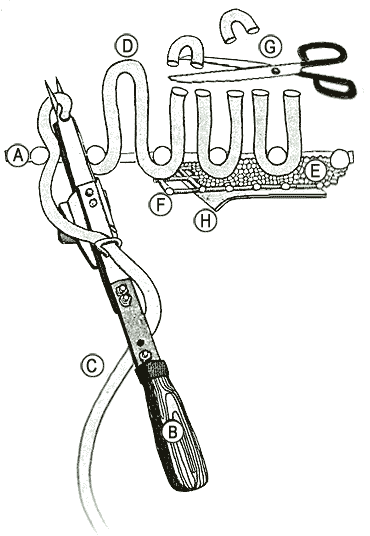
The hand-tufted rug looks and
feels very much like a hand-knotted rug. This is because it uses the same fine wool and dyes
as the fine knotted rugs use. It differs in the construction method. Instead of tying each
knot by hand, the tufted rug is made with a tufting gun (B) from the back of the rug.
(Rug hooking is similar but done from the front.) This method saves a lot of time
and keeps the price of the rug much lower than a knotted rug of equal size.
CONSTRUCTION STEPS
1.) Stretch foundation cloth (A) onto loom
2.) Ink design onto this same cloth
3.) Gun tuft the wool yarn (C) from the back of the cloth as shown above (D)
4.) Finish entire design changing yarn color as needed
5.) Take rug off loom and place it face down on floor
6.) Place scrim (F) upon back and apply layer of latex (E)
7.) After latex dries, shear face (G), wash and emboss
8.) Sew on the back cloth (H). (Protects floor surface from the roughness of the latex
and scrim.)
9.) Sew on fringe.
|
|
FLAT-WOVEN RUGS
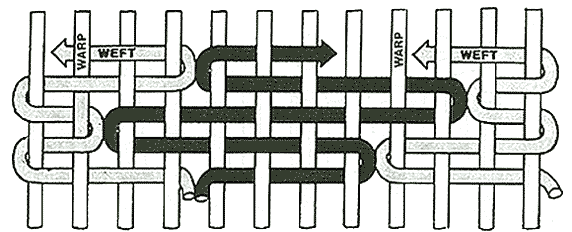
Flat-woven rugs have been made in many
areas for thousands of years. The designs come from the dyed wefts. There are no knots and
therefore no pile. They are generally less expensive and less durable than knotted rugs.
Flat-woven rugs are lightweight, easy to handle and normally reversible. A favorite of many
decorators.
COMMON METHODS OF CHANGING COLORS

SLIT WEAVE
WARP SHARING (DOVE TAILING) INTERLOCKING WEFTS
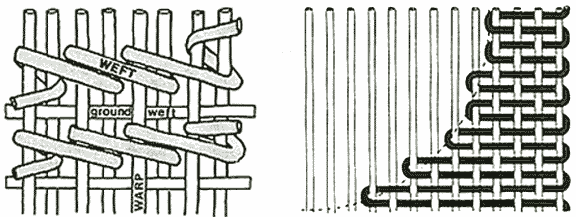
SOUMAK WEAVE
FLAT-WEAVE CIRCLE FORMATION
|
Quality Grading Systems
China, India and Pakistan each use their own unique system for grading rug quality by knot count.
Handmade rugs from any country (except China) are often graded by Knots Per Square Inch,
or KPSI - an impotant measure of a hand knotted rug's quality, value and even durability. A rug with
a higher knot count will typically possess the attributes of greater intricacy and clarity of design,
and is usually more expensive than a rug with a lower knot count, but with similar design features etc.
|
| Knots Per Square Inch (KPSI)
| RUG QUALITY RATING
|
|
KPSI Corresponds to the Pile Density of Wool |
|---|
| 30 KPSI | Very Coarse |
|---|
| 30 - 60 KPSI | Coarse |
|---|
| 60 - 130 KPSI | Medium Fine |
|---|
| 130 - 160 KPSI | Fine |
|---|
| 160 - 290 KPSI | Very Fine |
|---|
| 290 + KPSI | Extremely Fine |
|---|
|
|
By now you should be ready to apply these systems on real rugs! They are not so difficult
to learn (a magnifying glass and a ruler may be helpful), but remember - Indian, Chinese,
and Persian design Pakistan rugs show each knot only once, but a Pakistan Bokhara rug (for
example) shows each knot twice.
|
 India India
|  Pakistan Pakistan
| |
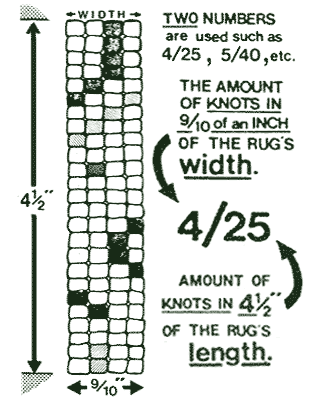
|
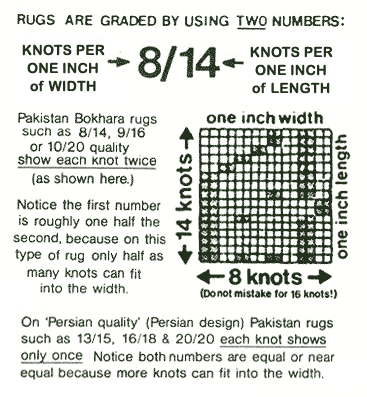 |
|
Rugs from India use a different standard of measure for counting knots
for the width: 9/10"; than for the length: 4½" - this relationship represented as a fraction (see above).
Knot density in rugs from Pakistan is graded by the square inch using 2 numbers represented as a fraction:
the first (top) for width and the second (bottom) for length, respectively.
Pakistan Bokhara rugs such as 8/14, 9/16 or 10/20 quality show each knot twice
(as shown here). Notice the first number is roughly one half the second,
because on this type of rug only half as many knots can fit
in the width. On 'Persian quality' (Persian design) Pakistan rugs
such as 13/15, 16/18 & 20/20 each knot shows only once (see above).
Notice both numbers are equal or near equal because more knots can fit into the width.
|
|
 China China
| All Chinese rugs are graded by "line count". Common line counts include
"70 line", "80 line" and "90 line" etc.:
| |

ONLY CHINESE RUGS USE THE "LINE COUNT" SYSTEM SHOWN IN ABOVE CONVERSION CHART
| |
The above numbers simply tell us how many knots are in a foot of the carpet's width.
A "100 line" rug has 100 knots in one linear foot across the width of the rug.
No other country uses this system.
|
|
Amazing But True!
A Chinese 90 line 9 × 12 rug has more than 10 miles of warp and weft threads in its foundation!
- Warp: 21,060 ft.
- Thin Weft: 25,952 ft.
- Thick Weft: 9,720 ft.
|
|
|
|
 Consumer Introduction | The Illustrated Rug | Illustrated Rugs 2 | Illustrated Rugs 3 | Illustrated Rugs 4 | From Sheep To Rug | Rug & Knot Types | Rug Loom Types
Consumer Introduction | The Illustrated Rug | Illustrated Rugs 2 | Illustrated Rugs 3 | Illustrated Rugs 4 | From Sheep To Rug | Rug & Knot Types | Rug Loom Types